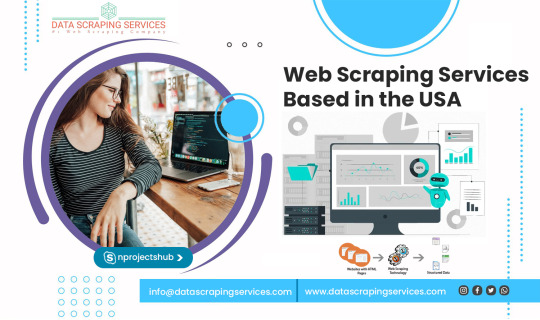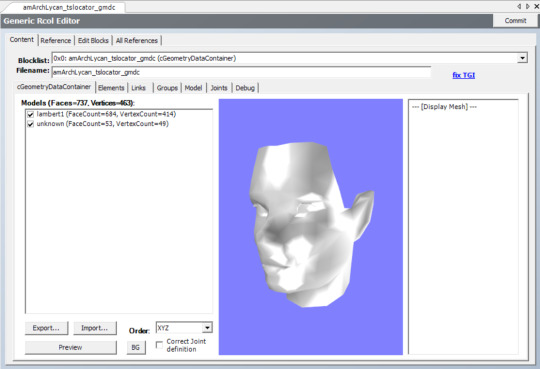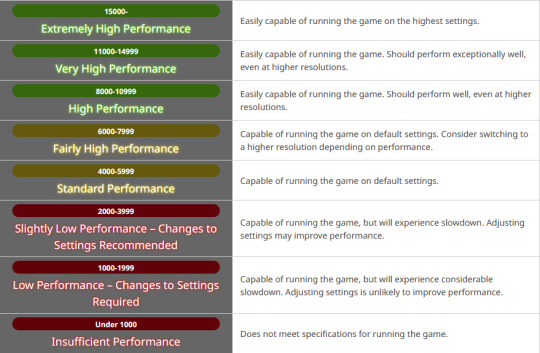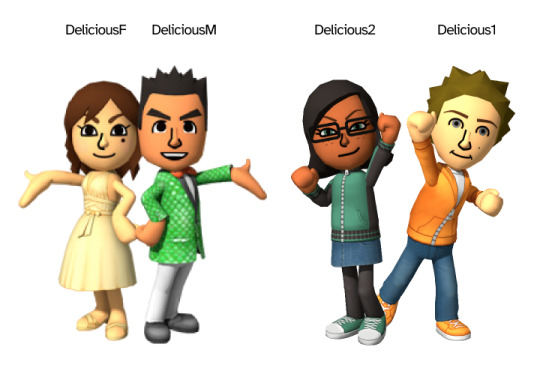#Custom Data Extraction
Explore tagged Tumblr posts
Text
The Role of Custom Web Data Extraction: Enhancing Business Intelligence and Competitive Advantage
Your off-the-shelf scraping tool worked perfectly last month. Then your target website updated their layout. Everything broke.
Your data pipeline stopped. Your competitive intelligence disappeared. Your team scrambled to fix scripts that couldn’t handle the new structure.
This scenario repeats across thousands of businesses using off-the-shelf extraction tools. Here’s the problem: 89% of leaders recognize web data’s importance. But standardized solutions fail when websites fight back with anti-bot defenses, dynamic content, or simple redesigns.
Custom extraction solves these problems. AI-powered systems see websites like humans do. They adapt automatically when things change.
This article reveals how custom web data extraction delivers reliable intelligence where off-the-shelf tools fail. You’ll discover why tailored solutions outperform one-size-fits-all approaches. You’ll also get to see a detailed industry-specific guide showing how business leaders solve their most complex data challenges.
Beyond Basic Scraping: What Makes Custom Web Data Extraction Different
Basic tools rely on rigid scripts. They expect websites to stay frozen in time. That’s simply not how the modern web works.
Today’s websites use sophisticated blocking techniques:
Rotating CAPTCHA challenges.
Browser fingerprinting.
IP rate limiting.
Complex JavaScript frameworks that render content client-side.
Custom solutions overcome these barriers. They use advanced capabilities you won’t find in basic tools.
Here’s what sets custom web data extraction apart:
Tailored architecture designed for your specific needs and target sources.
AI-powered browsers that render pages exactly as humans see them.
Intelligent IP rotation through thousands of addresses to avoid detection.
Automatic adaptation when target websites change their structure.
Enterprise-grade scale monitoring millions of pages across thousands of sources.
Basic tools might handle dozens of sites with hundreds of results. But they require constant babysitting from your team. Every website redesign breaks your scripts. Every new blocking technique stops your data flow.
On the other hand, enterprise-grade custom solutions monitor thousands of sources simultaneously. Their scrapers extract millions of data points with pinpoint accuracy and adapt automatically when sites change structure.
But here’s what really matters: intelligent data processing.
Raw scraped data is messy and inconsistent. Tailored solutions transform this chaos into structured intelligence by:
Cleaning and standardizing information automatically.
Matching products across different retailers despite varying naming conventions.
Identifying and flagging anomalies that could indicate data quality issues.
Structuring unstructured data into analysis-ready formats.
Industry research reveals that the technical barriers are real. 82% of organizations need help overcoming data collection challenges:
55% face IP blocking.
52% struggle with CAPTCHAs.
56% deal with dynamic content that traditional tools can’t handle.
This is why sophisticated businesses partner with experienced providers like Forage AI. We’ve perfected these capabilities over decades of experience and provide you with enterprise-grade capabilities without the headaches of maintaining complex infrastructure.
Now that you understand what makes custom extraction powerful, let’s see how this capability transforms the core business functions that drive competitive advantage.
Transforming Business Intelligence Across Key Functions
Custom web data extraction doesn’t just collect information. It revolutionizes how organizations understand their markets, customers, and competitive landscape.
Here’s how it transforms three critical business intelligence areas:
Real-Time Competitive Analysis
Forget checking competitor websites once a week. Custom extraction provides continuous competitive surveillance. It captures changes the moment they happen.
Your system monitors:
Pricing changes and product launches across competitor portfolios.
Executive appointments and organizational restructuring at target companies.
Regulatory filings and compliance updates from government sources.
Market expansion and strategic partnerships across your industry.
The competitive advantage:
Shift from reactive to proactive strategic positioning.
Respond within hours instead of days when competitors make a move.
Anticipate market shifts before other players spot them.
Position strategically based on live competitive intelligence.
Customer Intelligence & Market Insights
Understanding your customers means looking beyond your own data. You need to see how they behave across the entire market.
Custom extraction aggregates customer sentiment, preferences, and feedback from every relevant touchpoint online.
Comprehensive customer intelligence includes:
Review patterns across all major platforms to identify valued features.
Social media conversations to spot emerging trends before mainstream awareness.
Forum discussions to understand unmet needs representing new opportunities.
Purchase behavior signals across competitor platforms and review sites.
Strategic insights you gain:
Why customers choose competitors over you.
What actually drives their purchase decisions.
How their preferences evolve over time.
Which features and benefits resonate most strongly with your target market.
Operational Intelligence
Smart organizations use web data to optimize operations beyond marketing and sales. Custom extraction provides the external intelligence that makes internal operations more efficient and strategic.
Supply chain optimization through:
Supplier monitoring of websites, industry news, and regulatory announcements.
Commodity price tracking and shipping delay alerts.
Geopolitical event monitoring that could affect procurement strategies.
Risk management enhancement via:
Early warning signals from news sources and regulatory sites.
Compliance issue identification before they impact operations.
Reputation threat monitoring across digital channels.
Strategic planning support including:
Competitor expansion intelligence and market opportunity identification.
Industry trend analysis that shapes future strategy.
Market condition assessment for long-term decision-making.
This operational intelligence enables informed strategic planning. You gain comprehensive context for critical business decisions.
With these transformed business functions providing superior market intelligence, you’re positioned to create sustainable competitive advantages. But how exactly does this intelligence translate into lasting business benefits? Let’s examine the specific advantages that compound over time.
Creating Sustainable Competitive Advantages
The real power of custom web data extraction isn’t just better information. It’s the systematic advantages that compound over time. Your organization becomes increasingly difficult for competitors to match.
Speed and Agility
Research shows that 73% of organizations achieve quicker decision-making through systematic web data collection. But speed isn’t just about faster decisions. It’s about being first to market opportunities.
Immediate competitive benefits:
Capitalize on competitor pricing errors immediately rather than discovering them days later.
Adjust strategy while competitors are still gathering information.
Position yourself for new opportunities while others are still analyzing.
Compounding speed advantages:
Each quick response strengthens your market position. Customers associate your brand with market leadership. New opportunities become easier to capture.
Consider dynamic pricing strategies. They adjust in real-time based on competitor actions, inventory levels, and demand signals. Organizations using this approach report revenue increases of 5-25% compared to static pricing models.
Complete Market Coverage
While competitors rely on off-the-shelf tools that have limited coverage, custom extraction provides 360-degree market visibility. Industry research indicates that 98% of organizations need more data of at least one type. Tailored solutions eliminate this limitation entirely.
Your monitoring advantage includes:
Direct competitors and adjacent markets that could affect your business.
Pricing, inventory, promotions plus customer sentiment and regulatory changes.
Primary markets plus possibilities of international expansion.
Current conditions and emerging trends before they become obvious.
The scale difference is striking. Simple extraction tools can only handle dozens of products from a few sites before breaking down. Custom extraction monitors thousands of sources continuously with high accuracy. This creates market intelligence that’s simply impossible with off-the-shelf solutions.
Predictive Analytics Capability
With comprehensive, real-time data flowing systematically, you can build predictive capabilities. You anticipate market changes rather than just responding to them.
This is where Forage AI’s expertise becomes critical. We process data from 500M+ websites with AI-powered techniques, transforming raw information into strategic insights. 53% of organizations use public web data specifically to build the AI models that power these predictive insights.
Predictive intelligence detects:
Customer churn signals weeks before accounts show obvious warning signs.
Supply chain disruptions preventing inventory shortages before they impact operations.
Fraud detection patterns identifying suspicious activities before financial losses occur.
Lead scoring optimization predicting which prospects convert before competitors spot them.
The combination of speed, coverage, and prediction creates competitive advantages that are difficult for rivals to replicate. They’d need to invest in similar systematic data capabilities to match your market intelligence. By that time, you’ve gained additional advantages through earlier implementation.
These competitive benefits become even more powerful when applied to specific industry challenges. Let’s take a look at how different sectors leverage these capabilities for measurable ROI.
Industry-Specific Applications That Drive ROI
Different industries face unique competitive challenges. Custom web data extraction solves these in specific, measurable ways.
E-commerce & Retail
Retail operates in the most price-transparent market in history. 75% of retail organizations collect market data systematically while 51% use it specifically for brand health monitoring across multiple channels.
But here’s what sets custom extraction apart from basic extraction tools:
Visual Intelligence Engines: Extract and analyze product images across 1000+ competitor sites to identify color trends, style patterns, and merchandising strategies. Spot emerging visual trends 48 hours before they go mainstream by handling JavaScript-heavy product galleries that load dynamically as users scroll – something basic tools simply can’t manage.
Review Feature Mining: Go beyond sentiment scores. Extract unstructured review data to identify specific product features customers mention that aren’t in your specs. When customers repeatedly request “pockets” in competitor dress reviews, you’ll know before your next design cycle.
Micro-Influencer Discovery: Scrape social media platforms to find micro-influencers already organically mentioning your product category. Identify authentic voices with engaged audiences before they’re on anyone’s radar.
Stock Pattern Prediction: Monitor availability patterns across competitor sites to predict stockouts 7-10 days in advance. This isn’t just checking “in stock” labels – it’s analyzing restocking frequencies, quantity limits, and shipping delays.
Financial Services
Financial institutions face unique challenges around risk assessment, regulatory compliance, and market intelligence.
Custom extraction delivers capabilities impossible with standard tools:
Alternative Data Signals: Extract job postings, online company reviews, and web traffic patterns to assess company health 90 days before earnings reports. When a tech company suddenly posts 50 new sales positions while their engineering hiring freezes, you’ll spot the pivot early.
Multi-Language Regulatory Intelligence: Monitor 200+ regulatory websites across dozens of languages simultaneously for policy changes. Detect subtle shifts in compliance requirements weeks before official translations appear. This requires sophisticated language processing beyond basic translation.
ESG Risk Detection: Scrape news sites, NGO reports, and social media for real-time Environmental, Social, and Governance risk indicators. Identify supply chain controversies or environmental violations before they impact investment portfolios.
High-Frequency Data Extraction: Handle encrypted financial documents and real-time feeds from trading platforms. Process complex data structures that update milliseconds apart while maintaining accuracy.
Healthcare
Healthcare organizations need extraction capabilities that handle complex medical data and compliance requirements:
Clinical Trial Competition Intelligence: Extract real-time patient enrollment numbers and protocol changes from ClinicalTrials.gov and competitor sites. Know when rivals struggle with recruitment or modify trial endpoints. This means parsing complex medical documents and research papers.
Physician Opinion Tracking: Monitor medical forums and conference abstracts for emerging treatment preferences. Detect when specialists start discussing off-label uses or combination therapies 6 months before publication.
Drug Shortage Prediction: Combine Food and Drug Administration databases with pharmacy inventory signals to predict shortages 2-3 weeks early. Extract data from multiple formats while handling medical terminology variations.
Patient Journey Mapping: Analyze anonymized patient experiences from health forums to understand real treatment pathways. Navigate HIPAA-compliant extraction while capturing meaningful insights.
Manufacturing
Manufacturing requires extraction solutions that handle technical complexity across global supply chains:
Component Crisis Detection: Monitor 500+ distributor websites globally for lead time changes on critical components. Detect when a key supplier extends delivery from 8 to 12 weeks before it impacts your production line.
Patent Innovation Tracking: Extract and analyze competitor patent filings to identify technology directions 18 months before product launches. Parse technical specifications and CAD file references to understand true innovation patterns.
Quality Signal Detection: Mine consumer forums and review sites for early product defect patterns. Identify quality issues weeks before they escalate to recalls. This requires understanding technical language across multiple industries.
Sustainability Compliance Monitoring: Extract supplier ESG certifications, audit results, and environmental data from diverse sources. Track your entire supply chain’s compliance status in real-time across different reporting standards.
The Bottom Line: Measurable Impact Across Your Business
When you add it all up, custom web data extraction delivers three types of measurable value:
Immediate efficiency gains through automated intelligence gathering, reducing data processing time by 30-40% while improving decision speed and accuracy.
Revenue acceleration via dynamic pricing optimization (5-25% increases), market timing advantages, and strategic positioning based on comprehensive market understanding.
Risk reduction through early warning systems that spot threats before they impact operations, enabling proactive responses rather than costly reactive measures.
Organizations implementing these capabilities systematically are 57% more likely to expect significant revenue growth. The compound effect means early adopters gain advantages that become increasingly difficult for competitors to match.
These industry applications prove a key point. Sophisticated web data extraction isn’t just a technical capability. It’s a strategic business tool that drives measurable edge across diverse sectors and use cases.
Conclusion: Custom Data Extraction as Competitive Necessity
The evidence is clear. Organizations that systematically leverage web data consistently outperform those relying on manual methods or standard extraction techniques.
89% of business leaders recognize data’s importance. But only those implementing custom extraction solutions capture its full competitive potential.
This isn’t about having better tools. It’s about fundamentally transforming how you understand and respond to market dynamics. Custom web data extraction provides the systematic intelligence foundation that modern competitive strategy requires.
The question isn’t whether to invest in these capabilities. It’s how quickly you can implement them before competitors gain similar advantages.
Ready to stop guessing and start knowing? Contact Forage AI to discover how custom web data extraction can transform your competitive positioning and business intelligence capabilities.
0 notes
Text
Custom Data Extraction Services Provider in USA
0 notes
Text
What Are the Qualifications for a Data Scientist?
In today's data-driven world, the role of a data scientist has become one of the most coveted career paths. With businesses relying on data for decision-making, understanding customer behavior, and improving products, the demand for skilled professionals who can analyze, interpret, and extract value from data is at an all-time high. If you're wondering what qualifications are needed to become a successful data scientist, how DataCouncil can help you get there, and why a data science course in Pune is a great option, this blog has the answers.
The Key Qualifications for a Data Scientist
To succeed as a data scientist, a mix of technical skills, education, and hands-on experience is essential. Here are the core qualifications required:
1. Educational Background
A strong foundation in mathematics, statistics, or computer science is typically expected. Most data scientists hold at least a bachelor’s degree in one of these fields, with many pursuing higher education such as a master's or a Ph.D. A data science course in Pune with DataCouncil can bridge this gap, offering the academic and practical knowledge required for a strong start in the industry.
2. Proficiency in Programming Languages
Programming is at the heart of data science. You need to be comfortable with languages like Python, R, and SQL, which are widely used for data analysis, machine learning, and database management. A comprehensive data science course in Pune will teach these programming skills from scratch, ensuring you become proficient in coding for data science tasks.
3. Understanding of Machine Learning
Data scientists must have a solid grasp of machine learning techniques and algorithms such as regression, clustering, and decision trees. By enrolling in a DataCouncil course, you'll learn how to implement machine learning models to analyze data and make predictions, an essential qualification for landing a data science job.
4. Data Wrangling Skills
Raw data is often messy and unstructured, and a good data scientist needs to be adept at cleaning and processing data before it can be analyzed. DataCouncil's data science course in Pune includes practical training in tools like Pandas and Numpy for effective data wrangling, helping you develop a strong skill set in this critical area.
5. Statistical Knowledge
Statistical analysis forms the backbone of data science. Knowledge of probability, hypothesis testing, and statistical modeling allows data scientists to draw meaningful insights from data. A structured data science course in Pune offers the theoretical and practical aspects of statistics required to excel.
6. Communication and Data Visualization Skills
Being able to explain your findings in a clear and concise manner is crucial. Data scientists often need to communicate with non-technical stakeholders, making tools like Tableau, Power BI, and Matplotlib essential for creating insightful visualizations. DataCouncil’s data science course in Pune includes modules on data visualization, which can help you present data in a way that’s easy to understand.
7. Domain Knowledge
Apart from technical skills, understanding the industry you work in is a major asset. Whether it’s healthcare, finance, or e-commerce, knowing how data applies within your industry will set you apart from the competition. DataCouncil's data science course in Pune is designed to offer case studies from multiple industries, helping students gain domain-specific insights.
Why Choose DataCouncil for a Data Science Course in Pune?
If you're looking to build a successful career as a data scientist, enrolling in a data science course in Pune with DataCouncil can be your first step toward reaching your goals. Here’s why DataCouncil is the ideal choice:
Comprehensive Curriculum: The course covers everything from the basics of data science to advanced machine learning techniques.
Hands-On Projects: You'll work on real-world projects that mimic the challenges faced by data scientists in various industries.
Experienced Faculty: Learn from industry professionals who have years of experience in data science and analytics.
100% Placement Support: DataCouncil provides job assistance to help you land a data science job in Pune or anywhere else, making it a great investment in your future.
Flexible Learning Options: With both weekday and weekend batches, DataCouncil ensures that you can learn at your own pace without compromising your current commitments.
Conclusion
Becoming a data scientist requires a combination of technical expertise, analytical skills, and industry knowledge. By enrolling in a data science course in Pune with DataCouncil, you can gain all the qualifications you need to thrive in this exciting field. Whether you're a fresher looking to start your career or a professional wanting to upskill, this course will equip you with the knowledge, skills, and practical experience to succeed as a data scientist.
Explore DataCouncil’s offerings today and take the first step toward unlocking a rewarding career in data science! Looking for the best data science course in Pune? DataCouncil offers comprehensive data science classes in Pune, designed to equip you with the skills to excel in this booming field. Our data science course in Pune covers everything from data analysis to machine learning, with competitive data science course fees in Pune. We provide job-oriented programs, making us the best institute for data science in Pune with placement support. Explore online data science training in Pune and take your career to new heights!
#In today's data-driven world#the role of a data scientist has become one of the most coveted career paths. With businesses relying on data for decision-making#understanding customer behavior#and improving products#the demand for skilled professionals who can analyze#interpret#and extract value from data is at an all-time high. If you're wondering what qualifications are needed to become a successful data scientis#how DataCouncil can help you get there#and why a data science course in Pune is a great option#this blog has the answers.#The Key Qualifications for a Data Scientist#To succeed as a data scientist#a mix of technical skills#education#and hands-on experience is essential. Here are the core qualifications required:#1. Educational Background#A strong foundation in mathematics#statistics#or computer science is typically expected. Most data scientists hold at least a bachelor’s degree in one of these fields#with many pursuing higher education such as a master's or a Ph.D. A data science course in Pune with DataCouncil can bridge this gap#offering the academic and practical knowledge required for a strong start in the industry.#2. Proficiency in Programming Languages#Programming is at the heart of data science. You need to be comfortable with languages like Python#R#and SQL#which are widely used for data analysis#machine learning#and database management. A comprehensive data science course in Pune will teach these programming skills from scratch#ensuring you become proficient in coding for data science tasks.#3. Understanding of Machine Learning
3 notes
·
View notes
Text
Beyond Words: Unveiling the True ROI of Intelligent Document Processing (IDP)
Across industries—from manufacturing to insurance—businesses are under pressure to streamline operations, enhance customer experiences, and boost employee productivity, all while keeping costs in check. Intelligent Document Processing (IDP) is transforming how organizations handle documents by leveraging AI to automate data extraction and processing. But with any new technology, the big question remains: Is it worth the investment?
The Growing Importance of IDP
Traditional document handling is often plagued by delays, errors, and inefficiencies that frustrate employees and slow down critical business functions. IDP eliminates these bottlenecks by using AI to classify, extract, and validate information with speed and accuracy. Despite its advantages, some enterprises remain hesitant, uncertain about the true return on investment (ROI).
A structured approach to evaluating IDP’s financial and operational impact can help decision-makers build a solid business case for adoption. Understanding both the direct cost savings and broader benefits—like improved compliance, reduced risk, and enhanced decision-making—is key.
Measuring IDP’s ROI: A Data-Driven Approach
To bridge this knowledge gap, experts have developed a comprehensive framework that outlines key cost and benefit categories associated with IDP adoption. This approach enables businesses to estimate potential ROI through real-world applications, such as:
Invoice Processing – Faster, more accurate processing that reduces manual effort.
Insurance Claims Handling – Quicker claim settlements with fewer errors.
Customer Onboarding – Smoother, automated workflows that enhance user experience.
For organizations looking to maximize their IDP investments, understanding market trends and success factors is essential. Explore the latest insights and a proven ROI assessment framework to see how businesses are leveraging IDP for measurable gains.
About Us
IntentTech Insights™: Your Tech World Navigator
Uncharted waters demand a seasoned guide. We excel in providing intent-based technology intelligence to navigate complex technology landscapes, such as IT, cybersecurity, data storage and networks, SaaS, Cloud, Edge, IoT, AI, HR technologies, Contact Center software, Fintech, Martech, and 150+ other domains.
IntentTech Insights™ is your compass through the ever-evolving tech landscape. We are more than just a publication; we are your strategic partner in navigating the complexities of the digital world.
Our mission is to deliver unparalleled insights and actionable intelligence to tech professionals and enthusiasts alike. We delve deep into the latest trends, technologies, and innovations, providing comprehensive coverage that goes beyond surface-level reporting.
#Intelligent Document Processing#automate data extraction#Invoice Processing#Insurance Claims Handling#Customer Onboarding
0 notes
Text
Google Search Results Data Scraping

Google Search Results Data Scraping
Harness the Power of Information with Google Search Results Data Scraping Services by DataScrapingServices.com. In the digital age, information is king. For businesses, researchers, and marketing professionals, the ability to access and analyze data from Google search results can be a game-changer. However, manually sifting through search results to gather relevant data is not only time-consuming but also inefficient. DataScrapingServices.com offers cutting-edge Google Search Results Data Scraping services, enabling you to efficiently extract valuable information and transform it into actionable insights.
The vast amount of information available through Google search results can provide invaluable insights into market trends, competitor activities, customer behavior, and more. Whether you need data for SEO analysis, market research, or competitive intelligence, DataScrapingServices.com offers comprehensive data scraping services tailored to meet your specific needs. Our advanced scraping technology ensures you get accurate and up-to-date data, helping you stay ahead in your industry.
List of Data Fields
Our Google Search Results Data Scraping services can extract a wide range of data fields, ensuring you have all the information you need:
-Business Name: The name of the business or entity featured in the search result.
- URL: The web address of the search result.
- Website: The primary website of the business or entity.
- Phone Number: Contact phone number of the business.
- Email Address: Contact email address of the business.
- Physical Address: The street address, city, state, and ZIP code of the business.
- Business Hours: Business operating hours
- Ratings and Reviews: Customer ratings and reviews for the business.
- Google Maps Link: Link to the business’s location on Google Maps.
- Social Media Profiles: LinkedIn, Twitter, Facebook
These data fields provide a comprehensive overview of the information available from Google search results, enabling businesses to gain valuable insights and make informed decisions.
Benefits of Google Search Results Data Scraping
1. Enhanced SEO Strategy
Understanding how your website ranks for specific keywords and phrases is crucial for effective SEO. Our data scraping services provide detailed insights into your current rankings, allowing you to identify opportunities for optimization and stay ahead of your competitors.
2. Competitive Analysis
Track your competitors’ online presence and strategies by analyzing their rankings, backlinks, and domain authority. This information helps you understand their strengths and weaknesses, enabling you to adjust your strategies accordingly.
3. Market Research
Access to comprehensive search result data allows you to identify trends, preferences, and behavior patterns in your target market. This information is invaluable for product development, marketing campaigns, and business strategy planning.
4. Content Development
By analyzing top-performing content in search results, you can gain insights into what types of content resonate with your audience. This helps you create more effective and engaging content that drives traffic and conversions.
5. Efficiency and Accuracy
Our automated scraping services ensure you get accurate and up-to-date data quickly, saving you time and resources.
Best Google Data Scraping Services
Scraping Google Business Reviews
Extract Restaurant Data From Google Maps
Google My Business Data Scraping
Google Shopping Products Scraping
Google News Extraction Services
Scrape Data From Google Maps
Google News Headline Extraction
Google Maps Data Scraping Services
Google Map Businesses Data Scraping
Google Business Reviews Extraction
Best Google Search Results Data Scraping Services in USA
Dallas, Portland, Los Angeles, Virginia Beach, Fort Wichita, Nashville, Long Beach, Raleigh, Boston, Austin, San Antonio, Philadelphia, Indianapolis, Orlando, San Diego, Houston, Worth, Jacksonville, New Orleans, Columbus, Kansas City, Sacramento, San Francisco, Omaha, Honolulu, Washington, Colorado, Chicago, Arlington, Denver, El Paso, Miami, Louisville, Albuquerque, Tulsa, Springs, Bakersfield, Milwaukee, Memphis, Oklahoma City, Atlanta, Seattle, Las Vegas, San Jose, Tucson and New York.
Conclusion
In today’s data-driven world, having access to detailed and accurate information from Google search results can give your business a significant edge. DataScrapingServices.com offers professional Google Search Results Data Scraping services designed to meet your unique needs. Whether you’re looking to enhance your SEO strategy, conduct market research, or gain competitive intelligence, our services provide the comprehensive data you need to succeed. Contact us at [email protected] today to learn how our data scraping solutions can transform your business strategy and drive growth.
Website: Datascrapingservices.com
Email: [email protected]
#Google Search Results Data Scraping#Harness the Power of Information with Google Search Results Data Scraping Services by DataScrapingServices.com. In the digital age#information is king. For businesses#researchers#and marketing professionals#the ability to access and analyze data from Google search results can be a game-changer. However#manually sifting through search results to gather relevant data is not only time-consuming but also inefficient. DataScrapingServices.com o#enabling you to efficiently extract valuable information and transform it into actionable insights.#The vast amount of information available through Google search results can provide invaluable insights into market trends#competitor activities#customer behavior#and more. Whether you need data for SEO analysis#market research#or competitive intelligence#DataScrapingServices.com offers comprehensive data scraping services tailored to meet your specific needs. Our advanced scraping technology#helping you stay ahead in your industry.#List of Data Fields#Our Google Search Results Data Scraping services can extract a wide range of data fields#ensuring you have all the information you need:#-Business Name: The name of the business or entity featured in the search result.#- URL: The web address of the search result.#- Website: The primary website of the business or entity.#- Phone Number: Contact phone number of the business.#- Email Address: Contact email address of the business.#- Physical Address: The street address#city#state#and ZIP code of the business.#- Business Hours: Business operating hours#- Ratings and Reviews: Customer ratings and reviews for the business.
0 notes
Text
5 Best Data Analytics Certifications (June 2024)
New Post has been published on https://thedigitalinsider.com/5-best-data-analytics-certifications-june-2024/
5 Best Data Analytics Certifications (June 2024)
Having a strong foundation in data analytics is crucial for professionals seeking to advance their careers and make a meaningful impact in their organizations. With the growing demand for data analytics skills, numerous certifications have emerged to validate individuals’ expertise and set them apart in the job market. In this article, we will explore some of the best data analytics certifications available, each offering a unique blend of comprehensive training, hands-on experience, and industry recognition.
DataCamp offers a wide range of Data Analysis courses designed specifically for beginners, providing a solid foundation in the essential skills and tools needed to start a career in data analysis. These courses assume no prior experience and guide learners through the basics of data analysis using popular programming languages like Python and R, as well as essential tools such as Excel, SQL, and Tableau. With a focus on hands-on learning, DataCamp’s beginner courses ensure that learners gain practical experience from day one in their pursuit of a certificate.
The beginner-friendly courses cover a broad spectrum of topics, including data manipulation, data cleaning, exploratory data analysis, data visualization, and basic statistics. Learners engage with interactive exercises and real-world datasets, allowing them to apply their newly acquired skills in a practical context. The courses are taught by experienced instructors who break down complex concepts into easily digestible lessons, ensuring that even those with no prior experience can follow along and make steady progress.
DataCamp’s beginner Data Analysis courses are self-paced and flexible, allowing learners to fit learning into their schedules. Many of these courses are part of larger skill tracks and career tracks, providing learners with a clear roadmap for progressing from beginner to intermediate and advanced levels. By completing these beginner courses, learners build a strong foundation in data analysis and gain the confidence to tackle more complex projects and advance their careers in this exciting field.
Key components of DataCamp’s Data Analysis courses:
No prior experience required, guiding learners through the basics of data analysis using Python, R, Excel, SQL, and Tableau
Hands-on learning with interactive exercises and real-world datasets, allowing learners to gain practical experience
Broad coverage of essential topics, including data manipulation, cleaning, exploratory analysis, visualization, and basic statistics
Taught by experienced instructors who break down complex concepts into easily digestible lessons
Self-paced and flexible learning, with many courses part of larger skill tracks and career tracks for continued growth
IBM’s Introduction to Data Analytics course on Coursera provides a comprehensive introduction to the field of data analysis. The course is designed for beginners and does not require any prior experience in data analysis or programming. It aims to equip learners with a solid foundation in data analytics concepts, tools, and processes, preparing them for further learning and potential careers in the field.
The course is part of IBM’s Data Analyst Professional Certificate program, which consists of nine courses that cover various aspects of data analysis, from the basics to more advanced topics. Introduction to Data Analytics serves as the first course in this series, setting the stage for the subsequent courses. It is also included in other IBM programs, such as the Data Analysis and Visualization Foundations Specialization and the IBM Data Analytics with Excel and R Professional Certificate.
Throughout the course, learners engage with a variety of learning materials, including video lectures, readings, quizzes, and hands-on labs. The course culminates in a peer-reviewed final project, where learners apply their newly acquired knowledge to a real-world scenario. Upon completion, learners gain a clear understanding of the data analytics process, the roles and responsibilities of data professionals, and the various tools and technologies used in the field.
Key components of IBM’s Introduction to Data Analytics course:
Comprehensive introduction to data analytics concepts, tools, and processes
Part of IBM’s Data Analyst Professional Certificate program and other IBM offerings
Designed for beginners, with no prior experience required
Engaging learning materials, including video lectures, readings, quizzes, and hands-on labs
Peer-reviewed final project that applies course knowledge to a real-world scenario
Google’s Data Analytics Professional Certificate on Coursera is a comprehensive program designed to prepare individuals for a career in the high-growth field of data analytics. The certificate is suitable for beginners, with no prior experience or degree required. It aims to equip learners with in-demand skills and provide them with opportunities to connect with top employers in the industry.
The program consists of eight courses that cover various aspects of data analytics, including data collection, cleaning, analysis, visualization, and presentation. Learners gain hands-on experience with popular tools and platforms such as spreadsheets, SQL, Tableau, and R programming. The content is highly interactive and exclusively developed by Google employees with extensive experience in data analytics.
Throughout the program, learners engage with a mix of videos, assessments, and hands-on labs that simulate real-world data analytics scenarios. The certificate also includes a case study that learners can share with potential employers to showcase their newly acquired skills. Upon completion, graduates can directly apply for jobs with Google and over 150 U.S. employers, including Deloitte, Target, and Verizon.
Key components of Google’s Data Analytics Professional Certificate:
Comprehensive program designed for beginners, with no prior experience or degree required
Eight courses covering data collection, cleaning, analysis, visualization, and presentation
Hands-on experience with popular tools and platforms, such as spreadsheets, SQL, Tableau, and R programming
Highly interactive content exclusively developed by experienced Google employees
Opportunity to directly apply for jobs with Google and over 150 U.S. employers upon completion
The Digital Marketing Analytics: Data Analysis, Forecasting and Storytelling online short course from NUS is designed to help professionals make sense of the vast amounts of data available in today’s digital landscape. The course recognizes that while data is abundant, it must be effectively analyzed, visualized, and communicated to drive meaningful insights and decision-making. Over six weeks, participants develop a strong foundation in data analysis, visualization, and communication skills.
The course is particularly relevant for marketing and data professionals who want to expand their data analysis skills and effectively communicate insights to stakeholders. It is also suitable for senior business or marketing executives who rely on marketing data to inform strategies and decisions. Participants learn to use design and storytelling principles to create compelling data dashboards using Tableau, ultimately enabling them to present and interpret marketing data that can drive organizational success.
Throughout the course, participants engage with experts and gain hands-on experience with tools like Tableau and Orange. The curriculum covers a range of topics, including marketing analytics fundamentals, data storytelling, forecasting, predictive analytics for customer retention, segmentation and clustering techniques, and customer experience analysis. By the end of the course, participants are equipped with the knowledge and skills to make data-driven predictions, effectively target customers, and create impactful marketing strategies.
Key components of the Digital Marketing Analytics course from NUS on GetSmarter:
Six-week online short course focused on data analysis, visualization, and communication in marketing
Designed for marketing and data professionals, as well as senior business or marketing executives
Teaches participants to use design and storytelling principles to create compelling data dashboards using Tableau
Covers topics such as marketing analytics fundamentals, forecasting, predictive analytics, segmentation, and customer experience analysis
Equips participants with the skills to make data-driven predictions, target customers effectively, and create impactful marketing strategies
The Advanced Business Analytics Specialization, offered by the University of Colorado Boulder on Coursera, is designed to equip learners with real-world data analytics skills that can be applied to grow businesses, increase profits, and create maximum value for shareholders. The specialization brings together academic professionals and experienced practitioners to share their expertise and insights. Learners gain practical skills in extracting and manipulating data using SQL code, executing statistical methods for descriptive, predictive, and prescriptive analysis, and effectively interpreting and presenting analytic results.
Throughout the specialization, learners apply the skills they acquire to real business problems and datasets. They have opportunities to build conceptual models of businesses and simple database models, practice data extraction using SQL, apply predictive and prescriptive analytics to business problems, develop models for decision making, interpret software output, and present results and findings. The specialization utilizes basic Excel and the Analytic Solver Platform (ASP), an Excel plug-in, with learners participating in assignments able to access the software for free.
The specialization consists of four courses and a capstone project. The courses cover topics such as the analytical process, data creation, storage, and access, relational databases and SQL, predictive modeling techniques, exploratory data analysis, data visualization, optimization techniques for decision making, and communicating analytics results effectively. The capstone project allows learners to apply their skills to interpret a real-world dataset and make appropriate business strategy recommendations.
Key components of the Advanced Business Analytics Specialization:
Practical skills in data extraction, manipulation, and analysis using SQL code and statistical methods
Application of predictive and prescriptive analytics techniques to real business problems and datasets
Utilization of Excel and the Analytic Solver Platform (ASP) for hands-on learning
Four courses covering the analytical process, predictive modeling, business analytics for decision making, and communicating results
Capstone project to apply skills in interpreting real-world data and making business strategy recommendations
The Value of Data Analytics Certifications
Pursuing a data analytics certification is a valuable investment in your professional development. Whether you are a beginner looking to break into the field or an experienced professional seeking to enhance your skills, these certifications offer a wide range of options to suit your needs. By earning one of these certifications, you demonstrate your commitment to staying at the forefront of the data analytics field, expand your career opportunities, and position yourself as a data-driven leader in your organization.
#2024#Analysis#Analytics#Article#Best Of#Business#business analytics#career#Careers#Case Study#certification#Certifications#code#communication#comprehensive#content#course#coursera#courses#customer experience#customer retention#data#data analysis#data analyst#data analytics#data cleaning#data collection#data extraction#Data Visualization#data-driven
1 note
·
View note
Text
i have physical access to literally everything i need to sequence my own DNA and I have to restrain myself every day
#i could do it in 2 days#day1: collect sample (a mL of blood would be more than enough) and do extraction ..#could do extraction with the easymag but im p sure the DNEasy kit can also start with whole blood and is less scary than the easymag#then with the dna 1st round and second round pcr.. already have the primers if i wanted to determine my HLA type .. run the gel#i think i could do all that in day 1#day 2 would just be sequencing with the sanger sequencer and once the data is ready i could use our custom software or sequencher#like how cool would that be
0 notes
Text
: Discover the incredible advantages of custom extraction for your online business! With this powerful tool, you can unlock a whole new level of efficiency and productivity.
For More Information:-
0 notes
Text
There Were Always Enshittifiers

I'm on a 20+ city book tour for my new novel PICKS AND SHOVELS. Catch me in DC TONIGHT (Mar 4), and in RICHMOND TOMORROW (Mar 5). More tour dates here. Mail-order signed copies from LA's Diesel Books.

My latest Locus column is "There Were Always Enshittifiers." It's a history of personal computing and networked communications that traces the earliest days of the battle for computers as tools of liberation and computers as tools for surveillance, control and extraction:
https://locusmag.com/2025/03/commentary-cory-doctorow-there-were-always-enshittifiers/
The occasion for this piece is the publication of my latest Martin Hench novel, a standalone book set in the early 1980s called "Picks and Shovels":
https://us.macmillan.com/books/9781250865908/picksandshovels
The MacGuffin of Picks and Shovels is a "weird PC" company called Fidelity Computing, owned by a Mormon bishop, a Catholic priest, and an orthodox rabbi. It sounds like the setup for a joke, but the punchline is deadly serious: Fidelity Computing is a pyramid selling cult that preys on the trust and fellowship of faith groups to sell the dreadful Fidelity 3000 PC and its ghastly peripherals.
You see, Fidelity's products are booby-trapped. It's not merely that they ship with programs whose data-files can't be read by apps on any other system – that's just table stakes. Fidelity's got a whole bag of tricks up its sleeve – for example, it deliberately damages a specific sector on every floppy disk it ships. The drivers for its floppy drive initialize any read or write operation by checking to see if that sector can be read. If it can, the computer refuses to recognize the disk. This lets the Reverend Sirs (as Fidelity's owners style themselves) run a racket where they sell these deliberately damaged floppies at a 500% markup, because regular floppies won't work on the systems they lure their parishioners into buying.
Or take the Fidelity printer: it's just a rebadged Okidata ML-80, the workhorse tractor feed printer that led the market for years. But before Fidelity ships this printer to its customers, they fit it with new tractor feed sprockets whose pins are slightly more widely spaced than the standard 0.5" holes on the paper you can buy in any stationery store. That way, Fidelity can force its customers to buy the custom paper that they exclusively peddle – again, at a massive markup.
Needless to say, printing with these wider sprocket holes causes frequent jams and puts a serious strain on the printer's motors, causing them to burn out at a high rate. That's great news – for Fidelity Computing. It means they get to sell you more overpriced paper so you can reprint the jobs ruined by jams, and they can also sell you their high-priced, exclusive repair services when your printer's motors quit.
Perhaps you're thinking, "OK, but I can just buy a normal Okidata printer and use regular, cheap paper, right?" Sorry, the Reverend Sirs are way ahead of you: they've reversed the pinouts on their printers' serial ports, and a normal printer won't be able to talk to your Fidelity 3000.
If all of this sounds familiar, it's because these are the paleolithic ancestors of today's high-tech lock-in scams, from HP's $10,000/gallon ink to Apple and Google's mobile app stores, which cream a 30% commission off of every dollar collected by an app maker. What's more, these ancient, weird misfeatures have their origins in the true history of computing, which was obsessed with making the elusive, copy-proof floppy disk.
This Quixotic enterprise got started in earnest with Bill Gates' notorious 1976 "open letter to hobbyists" in which the young Gates furiously scolds the community of early computer hackers for its scientific ethic of publishing, sharing and improving the code that they all wrote:
https://en.wikipedia.org/wiki/An_Open_Letter_to_Hobbyists
Gates had recently cloned the BASIC programming language for the popular Altair computer. For Gates, his act of copying was part of the legitimate progress of technology, while the copying of his colleagues, who duplicated Gates' Altair BASIC, was a shameless act of piracy, destined to destroy the nascent computing industry:
As the majority of hobbyists must be aware, most of you steal your software. Hardware must be paid for, but software is something to share. Who cares if the people who worked on it get paid?
Needless to say, Gates didn't offer a royalty to John Kemeny and Thomas Kurtz, the programmers who'd invented BASIC at Dartmouth College in 1963. For Gates – and his intellectual progeny – the formula was simple: "When I copy you, that's progress. When you copy me, that's piracy." Every pirate wants to be an admiral.
For would-be ex-pirate admirals, Gates's ideology was seductive. There was just one fly in the ointment: computers operate by copying. The only way a computer can run a program is to copy it into memory – just as the only way your phone can stream a video is to download it to its RAM ("streaming" is a consensus hallucination – every stream is a download, and it has to be, because the internet is a data-transmission network, not a cunning system of tubes and mirrors that can make a picture appear on your screen without transmitting the file that contains that image).
Gripped by this enshittificatory impulse, the computer industry threw itself headfirst into the project of creating copy-proof data, a project about as practical as making water that's not wet. That weird gimmick where Fidelity floppy disks were deliberately damaged at the factory so the OS could distinguish between its expensive disks and the generic ones you bought at the office supply place? It's a lightly fictionalized version of the copy-protection system deployed by Visicalc, a move that was later publicly repudiated by Visicalc co-founder Dan Bricklin, who lamented that it confounded his efforts to preserve his software on modern systems and recover the millions of data-files that Visicalc users created:
http://www.bricklin.com/robfuture.htm
The copy-protection industry ran on equal parts secrecy and overblown sales claims about its products' efficacy. As a result, much of the story of this doomed effort is lost to history. But back in 2017, a redditor called Vadermeer unearthed a key trove of documents from this era, in a Goodwill Outlet store in Seattle:
https://www.reddit.com/r/VintageApple/comments/5vjsow/found_internal_apple_memos_about_copy_protection/
Vaderrmeer find was a Apple Computer binder from 1979, documenting the company's doomed "Software Security from Apple's Friends and Enemies" (SSAFE) project, an effort to make a copy-proof floppy:
https://archive.org/details/AppleSSAFEProject
The SSAFE files are an incredible read. They consist of Apple's best engineers beavering away for days, cooking up a new copy-proof floppy, which they would then hand over to Apple co-founder and legendary hardware wizard Steve Wozniak. Wozniak would then promptly destroy the copy-protection system, usually in a matter of minutes or hours. Wozniak, of course, got the seed capital for Apple by defeating AT&T's security measures, building a "blue box" that let its user make toll-free calls and peddling it around the dorms at Berkeley:
https://512pixels.net/2018/03/woz-blue-box/
Woz has stated that without blue boxes, there would never have been an Apple. Today, Apple leads the charge to restrict how you use your devices, confining you to using its official app store so it can skim a 30% vig off every dollar you spend, and corralling you into using its expensive repair depots, who love to declare your device dead and force you to buy a new one. Every pirate wants to be an admiral!
https://www.vice.com/en/article/tim-cook-to-investors-people-bought-fewer-new-iphones-because-they-repaired-their-old-ones/
Revisiting the early PC years for Picks and Shovels isn't just an excuse to bust out some PC nostalgiacore set-dressing. Picks and Shovels isn't just a face-paced crime thriller: it's a reflection on the enshittificatory impulses that were present at the birth of the modern tech industry.
But there is a nostalgic streak in Picks and Shovels, of course, represented by the other weird PC company in the tale. Computing Freedom is a scrappy PC startup founded by three women who came up as sales managers for Fidelity, before their pangs of conscience caused them to repent of their sins in luring their co-religionists into the Reverend Sirs' trap.
These women – an orthodox lesbian whose family disowned her, a nun who left her order after discovering the liberation theology movement, and a Mormon woman who has quit the church over its opposition to the Equal Rights Amendment – have set about the wozniackian project of reverse-engineering every piece of Fidelity hardware and software, to make compatible products that set Fidelity's caged victims free.
They're making floppies that work with Fidelity drives, and drives that work with Fidelity's floppies. Printers that work with Fidelity computers, and adapters so Fidelity printers will work with other PCs (as well as resprocketing kits to retrofit those printers for standard paper). They're making file converters that allow Fidelity owners to read their data in Visicalc or Lotus 1-2-3, and vice-versa.
In other words, they're engaged in "adversarial interoperability" – hacking their own fire-exits into the burning building that Fidelity has locked its customers inside of:
https://www.eff.org/deeplinks/2019/10/adversarial-interoperability
This was normal, back then! There were so many cool, interoperable products and services around then, from the Bell and Howell "Black Apple" clones:
https://forum.vcfed.org/index.php?threads%2Fbell-howell-apple-ii.64651%2F
to the amazing copy-protection cracking disks that traveled from hand to hand, so the people who shelled out for expensive software delivered on fragile floppies could make backups against the inevitable day that the disks stopped working:
https://en.wikipedia.org/wiki/Bit_nibbler
Those were wild times, when engineers pitted their wits against one another in the spirit of Steve Wozniack and SSAFE. That era came to a close – but not because someone finally figured out how to make data that you couldn't copy. Rather, it ended because an unholy coalition of entertainment and tech industry lobbyists convinced Congress to pass the Digital Millennium Copyright Act in 1998, which made it a felony to "bypass an access control":
https://www.eff.org/deeplinks/2016/07/section-1201-dmca-cannot-pass-constitutional-scrutiny
That's right: at the first hint of competition, the self-described libertarians who insisted that computers would make governments obsolete went running to the government, demanding a state-backed monopoly that would put their rivals in prison for daring to interfere with their business model. Plus ça change: today, their intellectual descendants are demanding that the US government bail out their "anti-state," "independent" cryptocurrency:
https://www.citationneeded.news/issue-78/
In truth, the politics of tech has always contained a faction of "anti-government" millionaires and billionaires who – more than anything – wanted to wield the power of the state, not abolish it. This was true in the mainframe days, when companies like IBM made billions on cushy defense contracts, and it's true today, when the self-described "Technoking" of Tesla has inserted himself into government in order to steer tens of billions' worth of no-bid contracts to his Beltway Bandit companies:
https://www.reuters.com/world/us/lawmakers-question-musk-influence-over-verizon-faa-contract-2025-02-28/
The American state has always had a cozy relationship with its tech sector, seeing it as a way to project American soft power into every corner of the globe. But Big Tech isn't the only – or the most important – US tech export. Far more important is the invisible web of IP laws that ban reverse-engineering, modding, independent repair, and other activities that defend American tech exports from competitors in its trading partners.
Countries that trade with the US were arm-twisted into enacting laws like the DMCA as a condition of free trade with the USA. These laws were wildly unpopular, and had to be crammed through other countries' legislatures:
https://pluralistic.net/2024/11/15/radical-extremists/#sex-pest
That's why Europeans who are appalled by Musk's Nazi salute have to confine their protests to being loudly angry at him, selling off their Teslas, and shining lights on Tesla factories:
https://www.malaymail.com/news/money/2025/01/24/heil-tesla-activists-protest-with-light-projection-on-germany-plant-after-musks-nazi-salute-video/164398
Musk is so attention-hungry that all this is as apt to please him as anger him. You know what would really hurt Musk? Jailbreaking every Tesla in Europe so that all its subscription features – which represent the highest-margin line-item on Tesla's balance-sheet – could be unlocked by any local mechanic for €25. That would really kick Musk in the dongle.
The only problem is that in 2001, the US Trade Rep got the EU to pass the EU Copyright Directive, whose Article 6 bans that kind of reverse-engineering. The European Parliament passed that law because doing so guaranteed tariff-free access for EU goods exported to US markets.
Enter Trump, promising a 25% tariff on European exports.
The EU could retaliate here by imposing tit-for-tat tariffs on US exports to the EU, which would make everything Europeans buy from America 25% more expensive. This is a very weird way to punish the USA.
On the other hand, not that Trump has announced that the terms of US free trade deals are optional (for the US, at least), there's no reason not to delete Article 6 of the EUCD, and all the other laws that prevent European companies from jailbreaking iPhones and making their own App Stores (minus Apple's 30% commission), as well as ad-blockers for Facebook and Instagram's apps (which would zero out EU revenue for Meta), and, of course, jailbreaking tools for Xboxes, Teslas, and every make and model of every American car, so European companies could offer service, parts, apps, and add-ons for them.
When Jeff Bezos launched Amazon, his war-cry was "your margin is my opportunity." US tech companies have built up insane margins based on the IP provisions required in the free trade treaties it signed with the rest of the world.
It's time to delete those IP provisions and throw open domestic competition that attacks the margins that created the fortunes of oligarchs who sat behind Trump on the inauguration dais. It's time to bring back the indomitable hacker spirit that the Bill Gateses of the world have been trying to extinguish since the days of the "open letter to hobbyists." The tech sector built a 10 foot high wall around its business, then the US government convinced the rest of the world to ban four-metre ladders. Lift the ban, unleash the ladders, free the world!
In the same way that futuristic sf is really about the present, Picks and Shovels, an sf novel set in the 1980s, is really about this moment.
I'm on tour with the book now – if you're reading this today (Mar 4) and you're in DC, come see me tonight with Matt Stoller at 6:30PM at the Cleveland Park Library:
https://www.loyaltybookstores.com/picksnshovels
And if you're in Richmond, VA, come down to Fountain Bookshop and catch me with Lee Vinsel tomorrow (Mar 5) at 7:30PM:
https://fountainbookstore.com/events/1795820250305

If you'd like an essay-formatted version of this post to read or share, here's a link to it on pluralistic.net, my surveillance-free, ad-free, tracker-free blog:
https://pluralistic.net/2025/03/04/object-permanence/#picks-and-shovels
#pluralistic#picks and shovels#history#web theory#marty hench#martin hench#red team blues#locus magazine#drm#letter to computer hobbyists#bill gates#computer lib#science fiction#crime fiction#detective fiction
498 notes
·
View notes
Text
I still think it's really cool how Amuro starts as the shittiest pilot alive (because he's a 15-year old) that only gets carried because he's in the biggest, fattest stat stick in-universe at the time (a few retroactive additions made in the future notwithstanding), enough that even its crappy vulcan guns are tearing Zaku IIs apart, and when he starts getting a bit too cocky, Char and Ramba Ral show up in objectively inferior pieces of junk and absolutely deliver his pizza, they just drag his face across every available surface in Planet Earth like he's a Yakuza mook, all because they are simply that much better at piloting, and the thing is, Amuro takes that very seriously.
He goes from shitass kid in an unfortunate situation that doesn't want to get in the robot to the most unwell child soldier in the war, which is really saying something, but most importantly, becomes so good at piloting the Gundam that the Gundam physically cannot handle Amuro's piloting. They need to apply "Magnetic Coating" to its joints so they don't fucking snap away from the main frame because Amuro, one, moves too damn well but also in too extreme a way for the frame to handle it, two, despite being equipped with two sabers, a shield, a beam rifle and vulcan guns, Amuro is a stern believer in introducing most everyone in thagomizer range to his Rated Z for Zeon hands, the single most official pair of hands in the business, tax free. He KEEP going Ip Man on these dudes, he does NOT need to do a Jamestown on these mother fuckers but he INSISTS. Somehow even the Gundam Hammer, which is a giant Hannah Barbera cartoon flail-- Ok, look at this thing, words do not do it justice

Even this god damn Tom and Jerry prop is less savage that whatever Amuro decides to do the moment he's done throwing his shield to get a free kill on someone and it officially becomes bed time forever for the unfortunate sap at the business end of his ten-finger weapons of mass destruction.
The RX-78-2, "Gundam" for its friends and family, even has a top of the line cutting edge Learning Computer that 'learns' alongside the pilot and their habits. This data extracted from it was so absolutely fucked up that it completely revolutionized Mobile Suit combat afterwards, which is a wholesome thing to think about when The Best Combat Data Ever came from a really angry, really stressed 15 year old that doesn't even like piloting. He was 15! He made Haro with his own hands! Amuro literally just wanted to make funny cute spherical robofriends! Amuro was out there trying to make Kirby real, but fate had other plans for him. His cloned brain put in a pilot seat is one of the setting's strongest 'pilots'.


They made fucking Shadow the Hedgehog with his brain, god damn.
By the end, Zeon is rolling out Gelgoogs out of its mass production lines. These things are in the Gundam's ballpark in terms of overall specs (or "power level"). Amuro is bodying them as if they were episode 1 Zaku IIs.
AND THEN HE GETS FUCKING PSYCHIC SPACE POWERS. Not that he needed them, he bodied a couple Space Psychics without any of those powers before awakening to them. But heaven's most violent child was not done evolving, whether he liked it or not.
Char bodied him in a souped up Zaku II at the start, a machine objectively inferior to the Gundam. Amuro more or less one-sidedly beats the shit out of Char when he's in a custom Commander-type Gelgoog that you could consider to be equal spec-wise to the Gundam. Amuro is the embodiment of Finding Out. He is Consequences. You tell him he better make it hurt, better make it count, better kill you in one shot, buddy, he needs half a fucking shot. The complete transformation. One could consider the central 75% of the show as long drawn out training montage turning a kid into the Geese Howard of giant robots.
2K notes
·
View notes
Text
MODDERS WANTED!
Maxis lost and found: Sims 2 werewolf faces?

Nope, I didn't use any custom face templates or sliders to make this render. This werewolf face IS in the game! Once again, nothing to download here, at least not for now. Hopefully we can make this an actual thing. All the details and research under the cut 🐺
So I was digging through the Pets EP files the other day for a project I had in mind when I found these meshes:

The "Arch" in the name caught my attention, because that's how the CAS face templates are named as well, so when I loaded the preview I found these really cool werewolf faces!

That got me thinking… this was probably intended for the werewolf transformations, right? Looks like the devs scrapped this idea on the final Pets release. @/hypersaline already restored the werewolf fangs, and I was wondering if it would be possible to restore these faces too.
Are "temporary face sliders" overlays even a thing in this game? The closest interaction I can think of is the Plastic Surgery station and its preset faces for the failed surgeries, but those just create a new face in the genetic data of the Sim, which is permanent unless the player gives them another plastic surgery session. The ideal thing would be morphing the face with these "sliders" when they transform into werewolves, and then remove them once they go back to their human shape.
Anyway, I figured I could extract the meshes and see if I could preview the faces in Blender just to showcase them. The files are pretty broken, they don't even have a UV map and the vertex order is all over the place. So after some tedious vertex snapping shenaningans I kinda remade them in Blender. Here's how they all look, compared to the base second face template in the game:

Adult Female Face (afArchLycan):
Adult Male Face (amArchLycan):

Teen Female Face (tfArchLycan):

Teen Male Face (tmArchLycan):

No elder faces as far as I know, and obviously children werewolves aren't a thing in the vanilla game.
The modding skills needed to restore something like this (if it's even possible) are way out of my scope. So yeah, if any modder knows a trick or two about how to implement this face transformation back in the game and feels brave enough to give this a try, please count me in! My DMs are open. I'll be more than happy to help with anything I'm able to on the meshing department 🙇♂️
Until then, at least here's a showcase archived of what could have been for Sims 2 werewolves 🌝
#maxis lost and found#ts2 pets#I've wanted something like this for werewolves for so long#but honestly I don't have much hope for this actually happening#who knows! now it's out there let's see what happens
362 notes
·
View notes
Text

Here's a mod that replaces around 70% of base game hood dog noises with very quiet bird sounds.
*There's also an option to disable Pets EP animal sounds, but that will only be useful for people who don't use Pets EP features.
Less Dog Barking Sounds in Neighborhood View
and optional: no Pets EP animal sounds*
Download (SFS)
I used this tool (MTS) to browse TS2 .xa sound files.
More info below the cut:
'Less Barking in hood view' mod package contains 36 dog barking & howling resources that I've found in base game Sound/Misc file. Yes, 36 - and that's not even all (!)
Lot background sounds are a mix of base game sfx and a f*ckload of additional, louder barking that comes with Pets EP.
So without Pets you might also hear some distant, quiet barking, but it's sparse. With Pets EP, it gets louder when you move the camera near the lot borders. It seems certain objects also emit barking sounds, like the trash can and mail box (??). It can even be heard in CAS.
Those sounds really bother me, but I don't like to play with background sfx switched off and was looking for a solution. Unfortunately, there's no perfect one :( - most of the Pets Misc resources seem to use SPX1 sound file format and cannot be opened (or at least I have no idea how to open it). Since I wrote this a python script has been released, LazyDuchess shared the re-converted sound resources that can be opened since it's mp3 format. I might go through these ad some point but not in the near future.
2. edited Misc.package is a PETS EP game file with all sounds removed from it. Unlike the mod, this file has custom installation instructions - it goes into your Sims 2 game installation folder /The Sims 2 Pets/TS Data/Res/Sound/
If you replace that file, pets in your game will be silent. Some other sounds related to Pets EP might also be missing.
Base game background sounds like little birds singing, crickets, frogs, owls hooting at night are NOT affected by this mod.
*I've been browsing TS2 sfx resources for a while now, extracted various sounds and replaced some with existing resources ( I haven't managed to replace any with new files tho) - it is probably possible (?) but files need to be in .xa format. MP3 files coded at 32000 Hz /48kbs seem to work.
319 notes
·
View notes
Text
Benchmark Tech Notes
Running the Benchmark
If your Benchmark isn't opening, it's an issue with the executable file, and something not completing properly on either download, or extracting the Zip file. The Benchmark is designed to run and give you scores for your potato computer, I promise.

I actually saved my Benchmark to my external drive, and it still pulls and saves data and runs as it should. Make sure you allowed the download to complete before extracting the zip.
Resolution
Check your Settings; in Display, it may be defaulting your monitor Resolution to something than you might otherwise use if you aren't on standard 1920x1080.
To check your monitor Resolution, minimize everything on your screen and right click anywhere on your Desktop. Go to Display Settings and scroll down to find Resolution and what it's set at.

You can set the Graphic Settings 1 tab to Maximum, or to Import your game settings. Display Settings tab is where you set it to be Windowed, Bordered, or Full Screen, as well as select Resolution to match your monitor in the dropdown (or customize it if needed). I speak on Resolution as some folks in my FC noted it changed how their characters looked.
The Other tab in Settings is where you can change the text output, or even check a box to disable the logo and score; I do this on subsequent plays, once I have my scores at various settings, to get the clean screenshots.
@calico-heart has a post about fixing graphics settings, with screenshots of the settings tab. Basically, change graphics upscaling from AMD to NVIDIA, and/or uncheck Enable Dynamic Resolution. Also check the Framerate Threshold dropdown.
Screenshots
The benchmark auto-saves 5 screens each playthrough. In the Benchmark folder there is a Screenshots folder to find the auto-images taken of your characters.





Character Appearance
If you want to get your current in game appearance, including non-standard hairstyles, make sure to load up the live game, right click and "Save Character Settings."
Then go to Documents/My Games/Final Fantasy XIV: A Realm Reborn (this is the default in Windows 10 so mileage varies). The file will have the date you last updated their settings and be named FFXIV_CHARA_01.dat (or however many saves you have/made).
Grab those newly updated DAT files for your character(s) and copy them, then in the same base folder, go to Final Fantasy XIV: A Realm Reborn (Benchmark).
Paste the copied DAT files in there, and rename to FFXIV_CHARA_BENCH01.dat (the number doesn't matter, and you may have more).
When running Benchmark Character Creation, use the dropdown menu.

If you do Create a Custom Character and Load Appearance Data, it will give you default hairstyles again. Meteor's Dawntrail hairstyle is a new default.
In Char Gen I am finding that a very pale hrothgal reflects the green scenery around her, giving her white skin/fur a green tinge. The other zones do not have this problem, or at least not to the same degree.
They added a Midday vs Evening setting in outdoor areas as well to test lighting. The lighting in the Gridanian innroom is better; not as bright as outdoors, to be expected, but not completely useless.

New voice type icons to clarifying the sounds you make.

Remember we're getting a free fantasia with the expansion, so some tweaking may be needed; Iyna I felt like I needed to adjust her jaw. Other colors--skin, hair, eyes, tattoos, etc--are showing differently in the various kinds of lighting.
Uncertain if the limit on hairstyles for the Hrothgals so far is just a Benchmark thing; they do have set styles for different head options. Everyone gets Meteor's hair though, so it may be a temporary/Benchmark limit. But which clan and face you choose drastically alters what hair and facial feature options you have access to.
Check your settings, tweak them a bit, play around with chargen, and remember this is still a Benchmark; they always strike me as a little less polished than the finished game, but so far I'm actually pretty pleased with having defined fingers and toes, the irises in the eyes, scars looking cut into the skin, and other improvements.
172 notes
·
View notes
Text

Fortune Street official artwork includes two images featuring Miis, to show off the game's ability to play as a Mii in addition to the various Mario and Dragon Quest series characters. However, the Miis used in that artwork do not appear in-game. The game offers a set of generic "guest Miis" if the player does not use a custom Mii, which these Miis are not included in.
Curiously, the data for these Miis is included in the game's code. When extracted, it is revealed that all four of them are named "Delicious" followed by a single character to tell them apart from each other. The names are listed above the Miis in the image. The reason for, or origin of, the "Delicious" name are unknown.
Main Blog | Twitter | Patreon | Source: twitter.com user "HEYimHeroic"
452 notes
·
View notes
Text
Genetic testing company 23andMe, once a Silicon Valley darling valued at $6 billion, filed for Chapter 11 bankruptcy protection late Sunday as it prepares for a sale of the business. CEO Anne Wojcicki, who cofounded the company in 2006, has also stepped down after months of failed attempts to take the firm private.
As uncertainty about the company’s future reaches its peak, all eyes are on the trove of deeply personal—and potentially valuable—genetic data that 23andMe holds. Privacy advocates have long warned that the risk of entrusting genetic data to any institution is twofold—the organization could fail to protect it, but it could also hand over customer data to a new entity that they may not trust and didn’t choose.
California attorney general Rob Bonta reminded consumers in an alert on Friday that Californians have a legal right to ask that an organization delete their data. 23andMe customers in other states and countries largely do not have the same protections, though there is also a right to deletion for health data in Washington state’s My Health My Data Act and the European Union’s General Data Protection Regulation. Regardless of residency, all 23andMe customers should consider downloading anything they want to keep from the service and should then attempt to delete their information.
“This situation really brings home the point that there is still no national health privacy law in the US protecting your rights unless you live in California or Washington,” says Andrea Downing, an independent security researcher and cofounder of the patient-led digital rights nonprofit The Light Collective. “Meanwhile, we continue to evolve our understanding of how genetic information has value, but also has unique vulnerability.”
John Verdi, senior vice president of policy at the Future of Privacy Forum, says 23andMe’s new owner could revise the company’s privacy policies for new customers and new data collection, but the data it has already collected from current customers is subject to existing terms. “The company has legal obligations regarding information collected under the current policies,” he says.
Still, researchers emphasize that in practice, such a large transition will create real data exposure that is outside of 23andMe customers’ control. “In my opinion, these privacy policies—especially in the context of acquisitions in the venture capital and private equity space—aren't worth the paper they're printed on,” says longtime security researcher and data privacy advocate Kenn White. “For regular people out there who use these services, you're pretty much on your own. My advice is to request your data get deleted as soon as possible"
To delete your genetic data through 23andMe’s website, log in and then go to Settings in your profile. Scroll to 23andMe Data and then click View. At this point, you can choose to download a copy of your genetic information. Then scroll to Delete Data and click Permanently Delete Data. Once you initiate the process, you’ll receive an email from 23andMe to confirm. Click the link in the email to complete the deletion process. Additionally, you can direct 23andMe to destroy the biological sample it used to extract your DNA data if you previously authorized the company to keep it. Go to Settings and then Preferences.
You can also opt in to and out of participating in research at any time by updating your consent status in your account settings. If you opt out, 23andMe will stop using your information for research going forward and will discontinue use of your data within 30 days. This does not affect studies that have already been completed.
23andMe has never been profitable and has struggled to revamp its business model since it went public in 2021. Demand for its ancestry and health testing kits has been declining for years. And data privacy has had a role to play in the company’s dwindling fortunes after the company was hit with a major data breach in December 2023 that affected millions of customers. The incident led to a class action lawsuit, which 23andMe agreed to settle for $30 million.
Last summer, Wojcicki filed a proposal to take the company private, which was rejected by 23andMe’s board of directors. Shortly after, the company shuttered its in-house drug discovery unit, and its board members resigned en masse over Wojcicki’s strategic direction.
23andMe says it intends to continue operating as usual throughout the sale process and that there are no immediate changes to the way it stores, manages, or protects customer data. In an open letter to customers, the company said it will “seek to find a partner who shares our commitment to customer data privacy and allows our mission of helping people access, understand and benefit from the human genome to live on.” But the direction of 23andMe will ultimately be in the hands of whoever takes over the company.
“If there is a new owner that comes out of the bankruptcy process, that new owner steps into the shoes of 23andMe and takes over those assets,” says Jennifer Wagner, an assistant professor of law, policy, and engineering and anthropology at Penn State University.
“They would still be bound by the complex web of contractual agreements that are in place right now with users,” Wagner adds. “But I think it does give rise to some uncertainty in terms of whether or not a new player would have the same values or that same kind of culture that 23andMe was trying to cultivate.”
23 notes
·
View notes
Text
[DOWNLOAD] DESATURATED (DEFAULT & CUSTOM) NEIGHBORHOOD CACTUS - UPDATED 07/09/2024

This is really a veeeeeery simple and fast texture edit on the neighborhood cactus that I made for a personal need! I didn't change the mesh, but only the texture, making it less saturated.
I had this file on my PC for a while and I was unsure whether to upload it because I haven't seen anyone playing with this type of desert terrain, but... maybe it can be useful to someone?
As you can see, the desert terrain I use is very light and that very saturated green didn't look very good with everything else, so I needed a desaturated cactus!
I remember that before removing all the default flora I had, the cactus were already desaturated, but searching through my removed cc I couldn't find a single default cactus (I guess I had a default of the lot cactus that also changed the texture of the neighborhood cactus at this point?)
The thing was...I wanted a cactus with a nice color without using a default that uses a high poly mesh, so I decided to just change the texture of maxis's cactus!


Unfortunately it's not a default replacement (I still have to figure out how to extract the hood decos with the included object data, so I can use the original guid and create a default! Please, if anyone knows how to do it, tell me ;;)
The desaturated color is the same from both the neighborhood and the lot-view and is very similar to the cactus for the lots! (And darker seems to have better quality too, I guess?)
UPDATED 07/09/2024
I ADDED THE DR VERSION!
DOWNLOAD (SFS)
#the sims 2#my cc#the sims 2 download#the sims 2 cc#the sims 2 custom content#the sims 2 hood deco#the sims 2 neighborhood
92 notes
·
View notes